外研版(2019) 必修第一册 Unit 2 Exploring English Starting out &Understanding Ideas 课件(共31张PPT 无听力音频素材)
文档属性
| 名称 | 外研版(2019) 必修第一册 Unit 2 Exploring English Starting out &Understanding Ideas 课件(共31张PPT 无听力音频素材) |  | |
| 格式 | ppt | ||
| 文件大小 | 17.3MB | ||
| 资源类型 | 教案 | ||
| 版本资源 | 外研版(2019) | ||
| 科目 | 英语 | ||
| 更新时间 | 2022-10-12 10:37:06 | ||
图片预览

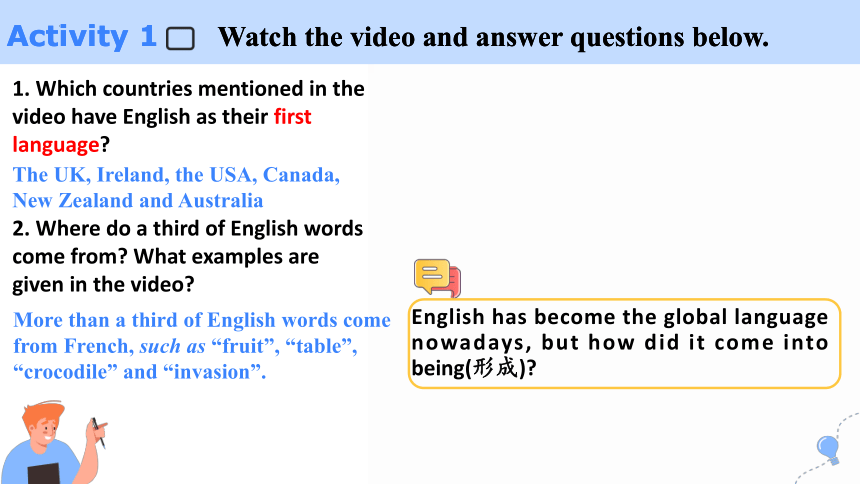
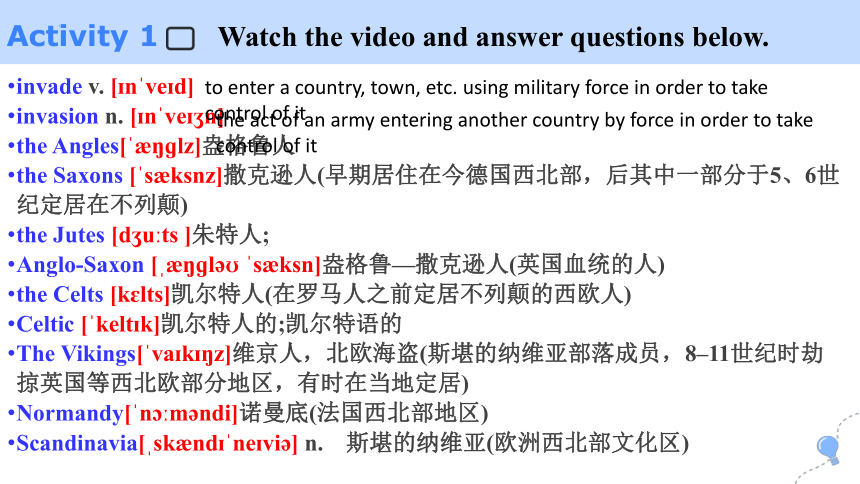

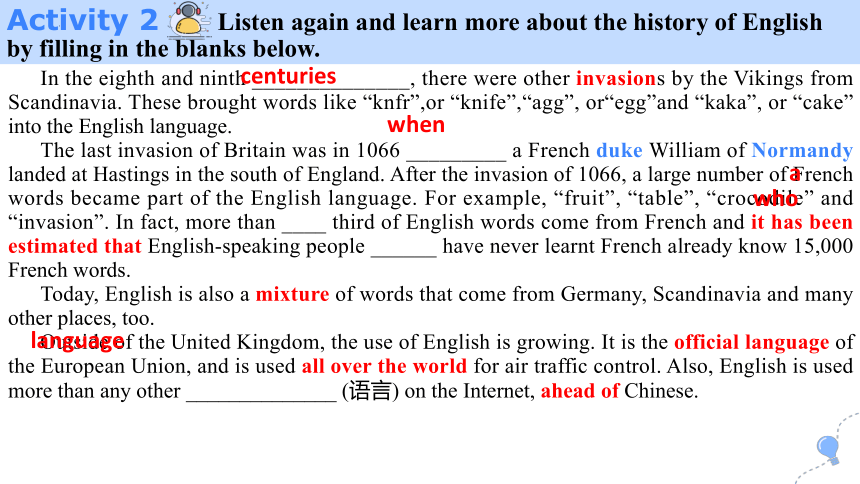
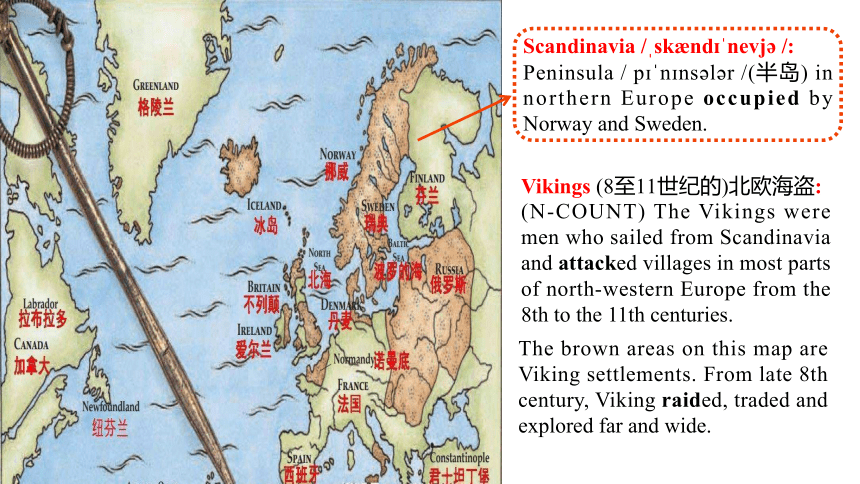
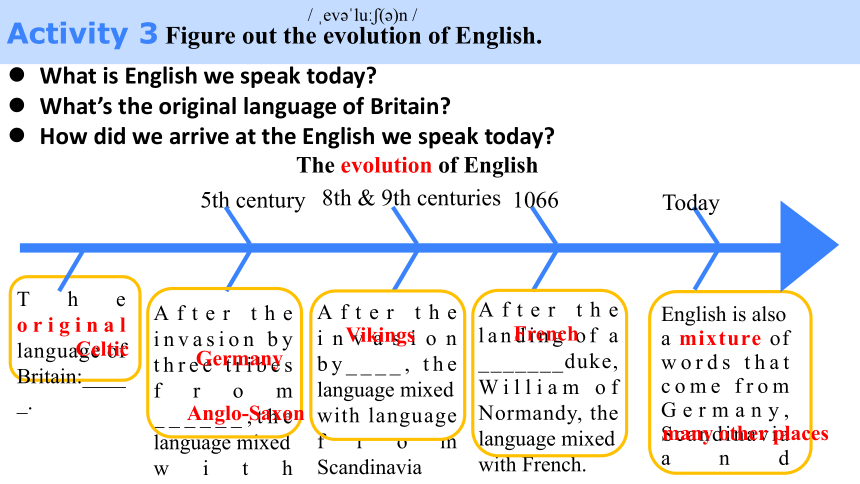



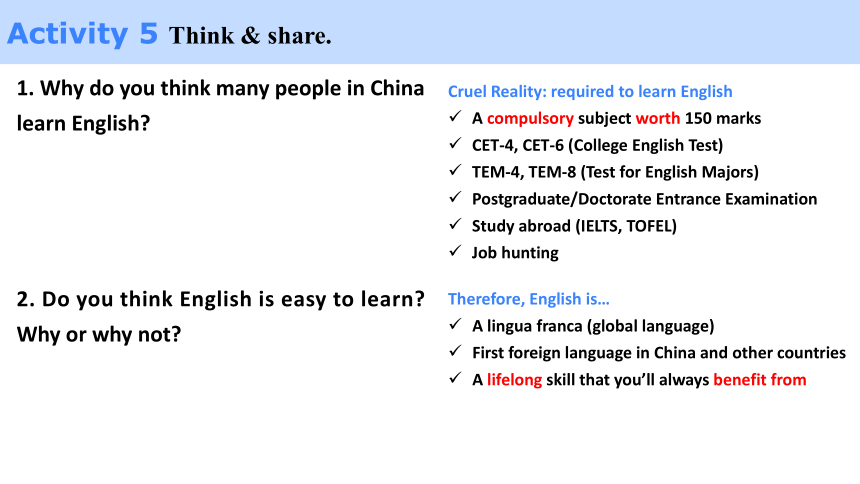
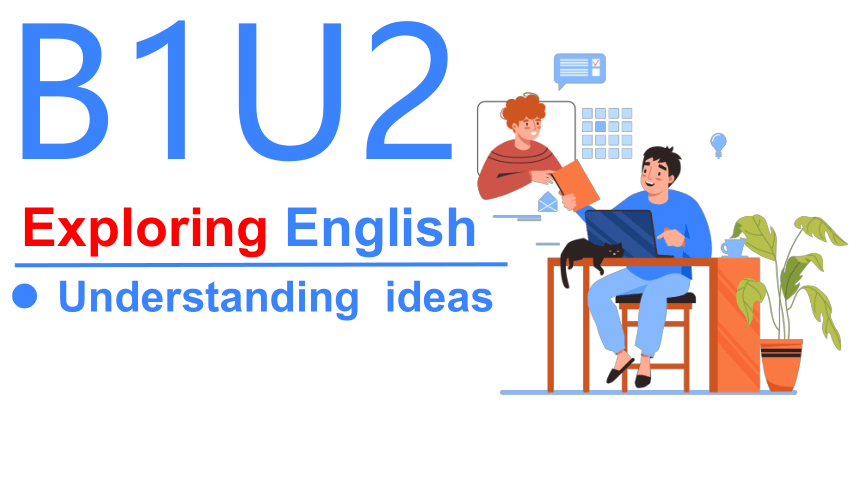
文档简介
(共31张PPT)
B1U2
Exploring English
Starting out
Activity 1 Watch the video and answer questions below.
1. Which countries mentioned in the video have English as their first language
2. Where do a third of English words come from What examples are given in the video
The UK, Ireland, the USA, Canada,
New Zealand and Australia
More than a third of English words come from French, such as “fruit”, “table”, “crocodile” and “invasion”.
English has become the global language nowadays, but how did it come into being(形成)
Activity 1 Watch the video and answer questions below.
Activity 1 Watch the video and answer questions below.
invade v. [ n ve d]
invasion n. [ n ve n]
the Angles[ ɡlz]盎格鲁人
the Saxons [ s ksnz]撒克逊人(早期居住在今德国西北部,后其中一部分于5、6世纪定居在不列颠)
the Jutes [d u ts ]朱特人;
Anglo-Saxon [ ɡl s ksn]盎格鲁—撒克逊人(英国血统的人)
the Celts [k lts]凯尔特人(在罗马人之前定居不列颠的西欧人)
Celtic [ kelt k]凯尔特人的;凯尔特语的
The Vikings[ va k z]维京人,北欧海盗(斯堪的纳维亚部落成员,8–11世纪时劫掠英国等西北欧部分地区,有时在当地定居)
Normandy[ n m ndi]诺曼底(法国西北部地区)
Scandinavia[ sk nd ne vi ] n. 斯堪的纳维亚(欧洲西北部文化区)
to enter a country, town, etc. using military force in order to take control of it
the act of an army entering another country by force in order to take control of it
Activity 2 Listen again and learn more about the history of English by filling in the blanks below.
The History of English
English is now the most common language in the world. It is the first language in the UK, Ireland, the USA, Canada, New Zealand and Australia. It is also the most popular second language, _______ means English is probably spoken by over one billion people around the world. But how did we _______ _____the English we speak today
The history of the English language begins in the fifth century ______ the invasion of Britain by three tribes from Germany – the Angles, Jutes and Saxons. The original language of Britain was an older European language called Celtic. Over time, most of the Celtic speakers were forced into the north and west of the British Isles. The invaders spoke a language called Anglo-Saxon and many of the most common words in English come from this. The Anglo-Saxon word “hus” became house, “scip” became ship, “c ” became “cow” and “cild” became “child”.
which
arrive at
with
Activity 2 Listen again and learn more about the history of English by filling in the blanks below.
In the eighth and ninth ______________, there were other invasions by the Vikings from Scandinavia. These brought words like “knfr”,or “knife”,“agg”, or“egg”and “kaka”, or “cake” into the English language.
The last invasion of Britain was in 1066 _________ a French duke William of Normandy landed at Hastings in the south of England. After the invasion of 1066, a large number of French words became part of the English language. For example, “fruit”, “table”, “crocodile” and “invasion”. In fact, more than ____ third of English words come from French and it has been estimated that English-speaking people ______ have never learnt French already know 15,000 French words.
Today, English is also a mixture of words that come from Germany, Scandinavia and many other places, too.
Outside of the United Kingdom, the use of English is growing. It is the official language of the European Union, and is used all over the world for air traffic control. Also, English is used more than any other ______________ (语言) on the Internet, ahead of Chinese.
when
a
who
language
centuries
Scandinavia / sk nd nevj /:
Peninsula / p n ns l r /(半岛) in northern Europe occupied by Norway and Sweden.
Vikings (8至11世纪的)北欧海盗:
(N-COUNT) The Vikings were men who sailed from Scandinavia and attacked villages in most parts of north-western Europe from the 8th to the 11th centuries.
The brown areas on this map are Viking settlements. From late 8th century, Viking raided, traded and explored far and wide.
1066
After the landing of a _______duke, William of Normandy, the language mixed with French.
8th & 9th centuries
After the invasion by____, the language mixed with language from Scandinavia
5th century
After the invasion by three tribes from ______,the language mixed with _________.
Activity 3 Figure out the evolution of English.
What is English we speak today
What’s the original language of Britain
How did we arrive at the English we speak today
The original language of Britain:_____.
English is also a mixture of words that come from Germany, Scandinavia and ___________, too.
The evolution of English
Celtic
Germany
Anglo-Saxon
Vikings
French
Today
many other places
/ ev lu ( )n /
Activity 4 Look at the charts and answer the questions.
According to Chart 1, which language has the largest number of native speakers
Chinese 1,390 million
Because China has the largest population in the world.
印地-乌尔都语
阿拉伯语
西班牙语
Activity 4 Look at the charts and answer the questions.
2. According to Chart 2, which language has the largest number of learners
English
1,500 million
Among these 1,500 million English learners, do you know how many learners are there in China
Activity 4 Look at the charts and answer the questions.
3. What conclusion can you draw from Chart 3
50 million
200 million
300 million
The number of English Learners in China is increasing greatly.
Activity 5 Think & share.
1. Why do you think many people in China learn English
2. Do you think English is easy to learn Why or why not
Cruel Reality: required to learn English
A compulsory subject worth 150 marks
CET-4, CET-6 (College English Test)
TEM-4, TEM-8 (Test for English Majors)
Postgraduate/Doctorate Entrance Examination
Study abroad (IELTS, TOFEL)
Job hunting
Therefore, English is…
A lingua franca (global language)
First foreign language in China and other countries
A lifelong skill that you’ll always benefit from
B1U2
Exploring English
Understanding ideas
Pre-reading
Look at the title of the passage and the pictures. Tick what you think the passage is about.
Title:
Neither Pine nor Apple in Pineapple
□ food
□ cooking
□ words
□ plants
□ fruit
Read the passage and check your answer to Activity 1.
While-reading
Task 1 Fast reading
1. What made the author think more about English
A. Finding no egg in the eggplant.
B. Needing a hamburger to feed the child.
C. Meeting trouble in learning English.
D. The question raised by the child.
While-reading
Task 1 Fast reading
2. Why does the author say “English was invented by people”
A. Because the English words show everything around us.
B. Because the language helps us communicate with others.
C. Because the language proves how creative human being is.
D. Because the English words are unique in the world.
While-reading
Task 1 Fast reading
3. What’s the author’s purpose in writing the passage
A. To tell us that English is very difficult to learn.
B. To give advice on how to learn English.
C. To show that English is interesting and creative.
D. To explain how English was created.
Tips on reading
How to get the main idea of a passage quickly
Analyze the title and the pictures carefully and predict.
Read for the topic sentence, which is usually in the first or last paragraph.
Read the first sentence of each paragraph.
Pay attention to the structure of the passage.
While-reading
Task 1 Fast reading
4. How does the author support his/her idea in the passage
A. By providing examples.
B. By making comparisons.
C. By following the order of importance.
D. By following the way of spelling.
While-reading
(小品文):
A piece of writing, usually short, that deals with a subject or a topic in a limited way, and express a particular point of view.
Type:________
Essay
Neither Pine nor Apple in Pineapple
Structure
Topic: para _____
Opinion:para _____
Examples:para _____
1
7
2-6
View
Task 2 Intensive Reading — Reading for the type and structure
Topic
While-reading
Task 3 Intensive Reading — Reading for details
Complete the notes with words from the passage.
no egg in eggplant
no ham in 2.__________
neither pine nor apple in
3. ____________
sculpt a sculpture
paint a(n) 4.______________
BUT take a photo
In order to support his idea, the author uses many examples that show the 1.__________ madness of English.
unique
hamburger
pineapple
painting
We can’t always understand a compound word by adding the meanings of the words it is made up of!
While-reading
Task 3 Intensive Reading — Reading for details
Complete the notes with words from the passage.
seasick → sick at sea
5.________ → sick in the air
6.__________ → sick in a car
BUT 7. __________ → sick at home
“Hard” is the opposite of “soft”.
“hardly “ and “softly” are not a(n) 8.___________ pair.
In order to support his idea, the author uses many examples that show the unique madness of English.
The same rule doesn’t always apply to everything!
airsick
carsick
homesick
opposing
While-reading
Task 3 Intensive Reading — Reading for details
Complete the notes with words from the passage.
“Harmless” is the opposite of “harmful”.
Shameful and shameless 9.__________ are the same.
burn up → burn down
fill in a form → 10. _______a form
In order to support his idea, the author uses many examples that show the unique madness of English.
Seemingly opposite words or phrases may have the same meaning!
behaviors
fill out
While-reading
Task 3 Intensive Reading — Reading for details
Complete the notes with words from the passage.
Stars are out . → They are visible.
Lights are out. → They are 11.__________.
I wind up my watch. →It starts.
I wind up the passage. →
It 12.________.
In order to support his idea, the author uses many examples that show the unique madness of English.
The same words and phrases may have different meanings in different contexts.
invisible
ends
While-reading
Task 3 Intensive Reading — Reading for details
Complete the notes with words from the passage.
The reason is that English was invented by people, and it 13.__________ the creativity of the human race.
Why do the author think English is interesting and creative
reflects
Can you find the sentence patterns the author uses to give examples
How does the author give examples
Sentence patterns:
1. For example, we ..., but we ...
2. When we..., we can. But when we..., we can’t....
3. If..., why (not)...
While-reading
Task 4 Intensive Reading — Reading for sentence patterns and writing techniques
The author explains his / her opinion ( English is interesting and creative.) by_________________________________________________
comparison
reasoning
comparing/making comparisons and reasoning.
While-reading
Task 5 Conclusion
Para2:__________________________________________________________________________________________________________________________________Para3:____________________________________________________________________________
Para4:______________________
Para5:______________________Para6:_________________________________________________
Neither Pine nor Apple in Pineapple
Topic: ________________________________________________
Opinion:
English _________by people and it __________________ of the human race.
Examples
Type:________
Essay
English can be a crazy language to learn.
was invented
reflects the creativity
⑦harmless & harmful⑧shameless & shameful
⑨raining/snowing/sunny
⑩WHO/IT/US
burn up & burn down fill in
& fill out go off out wind up
⑤hard & soft⑥hardly & softly
①eggplant/hamburger/pineapple
② sculpt a sculpture/paint a painting/take a photo ③in the car or taxi/ on the train or bus④seasick/carsick/homesick/homework/housework
Further-reading The origin of some words
1. The word “pineapple” developed from the Spanish word “pina”, which means pine cone. When it came to England, “apple” was added to show it is a kind of fruit.
2. The origin of “hamburger” was a hard beef steak called “Hamburg steak”, eaten without bread. Later, people reinvented it and called it “hamburger”.
3. Eggplants used to be smaller and yellow or white. They looked a bit like eggs, which led to the name “eggplant”.
How did pineapples, hamburgers and eggplants get their names
There is a reason!!!
Post-reading
Task 1 Think & share
Can you find similar examples in Chinese
In the future, what attitude should we take while coming across some seemingly “crazy” language
Do you agree with the author’s opinion about the English language Give your reasons.
There is a reason for everything. Though it is a mystery to me now, I know it won’t always be so.
by Ben Sherwood
Post-reading
Task 2 Imitate and create
1.While we are doing all this travelling, we can get seasick at sea, airsick in the air and carsick in a car, but we don’t get homesick when we get back home.
2. When we look out of the window and see rain or snow, we can say “it’s raining” or “it’s snowing”. But when we see sunshine, we can’t say “it’s sunshining”.
Create
We can go to work ________ and take a trip ________, but we get back home ________.
by bus
by car
on foot
Post-reading
Task 2 Imitate and create
1. If “hard” is the opposite of “soft”, why are “hardly” and “softly” not an opposing pair
2. If harmless actions are the opposite of harmful actions, why are shameless and shameful behaviors the same
Create
If “__________” means “not active” and “____________” means “not complete”, why does “______________” mean “very valuable”/ why doesn’t “invaluable” mean “not valuable”
inactive
incomplete
invaluable
valueless: not valuable
Post-reading
Task 1 Imitate and create
but
if…why (not)...
I think English is a crazy language. For example, …
Create
luckily/quickly/slowly/likely (adj.)
It is the creativity, craziness and complexity that makes a language unique, interesting and enjoyable to learn.
Take a flexible attitude, be open-minded and keep on exploring the reasons behind a language.
Assignment
List more examples to show English can be a crazy English by using the sentence patterns you learnt.
Think & share
What do you find most challenging about learning English
How do you deal with this
B1U2
Exploring English
Starting out
Activity 1 Watch the video and answer questions below.
1. Which countries mentioned in the video have English as their first language
2. Where do a third of English words come from What examples are given in the video
The UK, Ireland, the USA, Canada,
New Zealand and Australia
More than a third of English words come from French, such as “fruit”, “table”, “crocodile” and “invasion”.
English has become the global language nowadays, but how did it come into being(形成)
Activity 1 Watch the video and answer questions below.
Activity 1 Watch the video and answer questions below.
invade v. [ n ve d]
invasion n. [ n ve n]
the Angles[ ɡlz]盎格鲁人
the Saxons [ s ksnz]撒克逊人(早期居住在今德国西北部,后其中一部分于5、6世纪定居在不列颠)
the Jutes [d u ts ]朱特人;
Anglo-Saxon [ ɡl s ksn]盎格鲁—撒克逊人(英国血统的人)
the Celts [k lts]凯尔特人(在罗马人之前定居不列颠的西欧人)
Celtic [ kelt k]凯尔特人的;凯尔特语的
The Vikings[ va k z]维京人,北欧海盗(斯堪的纳维亚部落成员,8–11世纪时劫掠英国等西北欧部分地区,有时在当地定居)
Normandy[ n m ndi]诺曼底(法国西北部地区)
Scandinavia[ sk nd ne vi ] n. 斯堪的纳维亚(欧洲西北部文化区)
to enter a country, town, etc. using military force in order to take control of it
the act of an army entering another country by force in order to take control of it
Activity 2 Listen again and learn more about the history of English by filling in the blanks below.
The History of English
English is now the most common language in the world. It is the first language in the UK, Ireland, the USA, Canada, New Zealand and Australia. It is also the most popular second language, _______ means English is probably spoken by over one billion people around the world. But how did we _______ _____the English we speak today
The history of the English language begins in the fifth century ______ the invasion of Britain by three tribes from Germany – the Angles, Jutes and Saxons. The original language of Britain was an older European language called Celtic. Over time, most of the Celtic speakers were forced into the north and west of the British Isles. The invaders spoke a language called Anglo-Saxon and many of the most common words in English come from this. The Anglo-Saxon word “hus” became house, “scip” became ship, “c ” became “cow” and “cild” became “child”.
which
arrive at
with
Activity 2 Listen again and learn more about the history of English by filling in the blanks below.
In the eighth and ninth ______________, there were other invasions by the Vikings from Scandinavia. These brought words like “knfr”,or “knife”,“agg”, or“egg”and “kaka”, or “cake” into the English language.
The last invasion of Britain was in 1066 _________ a French duke William of Normandy landed at Hastings in the south of England. After the invasion of 1066, a large number of French words became part of the English language. For example, “fruit”, “table”, “crocodile” and “invasion”. In fact, more than ____ third of English words come from French and it has been estimated that English-speaking people ______ have never learnt French already know 15,000 French words.
Today, English is also a mixture of words that come from Germany, Scandinavia and many other places, too.
Outside of the United Kingdom, the use of English is growing. It is the official language of the European Union, and is used all over the world for air traffic control. Also, English is used more than any other ______________ (语言) on the Internet, ahead of Chinese.
when
a
who
language
centuries
Scandinavia / sk nd nevj /:
Peninsula / p n ns l r /(半岛) in northern Europe occupied by Norway and Sweden.
Vikings (8至11世纪的)北欧海盗:
(N-COUNT) The Vikings were men who sailed from Scandinavia and attacked villages in most parts of north-western Europe from the 8th to the 11th centuries.
The brown areas on this map are Viking settlements. From late 8th century, Viking raided, traded and explored far and wide.
1066
After the landing of a _______duke, William of Normandy, the language mixed with French.
8th & 9th centuries
After the invasion by____, the language mixed with language from Scandinavia
5th century
After the invasion by three tribes from ______,the language mixed with _________.
Activity 3 Figure out the evolution of English.
What is English we speak today
What’s the original language of Britain
How did we arrive at the English we speak today
The original language of Britain:_____.
English is also a mixture of words that come from Germany, Scandinavia and ___________, too.
The evolution of English
Celtic
Germany
Anglo-Saxon
Vikings
French
Today
many other places
/ ev lu ( )n /
Activity 4 Look at the charts and answer the questions.
According to Chart 1, which language has the largest number of native speakers
Chinese 1,390 million
Because China has the largest population in the world.
印地-乌尔都语
阿拉伯语
西班牙语
Activity 4 Look at the charts and answer the questions.
2. According to Chart 2, which language has the largest number of learners
English
1,500 million
Among these 1,500 million English learners, do you know how many learners are there in China
Activity 4 Look at the charts and answer the questions.
3. What conclusion can you draw from Chart 3
50 million
200 million
300 million
The number of English Learners in China is increasing greatly.
Activity 5 Think & share.
1. Why do you think many people in China learn English
2. Do you think English is easy to learn Why or why not
Cruel Reality: required to learn English
A compulsory subject worth 150 marks
CET-4, CET-6 (College English Test)
TEM-4, TEM-8 (Test for English Majors)
Postgraduate/Doctorate Entrance Examination
Study abroad (IELTS, TOFEL)
Job hunting
Therefore, English is…
A lingua franca (global language)
First foreign language in China and other countries
A lifelong skill that you’ll always benefit from
B1U2
Exploring English
Understanding ideas
Pre-reading
Look at the title of the passage and the pictures. Tick what you think the passage is about.
Title:
Neither Pine nor Apple in Pineapple
□ food
□ cooking
□ words
□ plants
□ fruit
Read the passage and check your answer to Activity 1.
While-reading
Task 1 Fast reading
1. What made the author think more about English
A. Finding no egg in the eggplant.
B. Needing a hamburger to feed the child.
C. Meeting trouble in learning English.
D. The question raised by the child.
While-reading
Task 1 Fast reading
2. Why does the author say “English was invented by people”
A. Because the English words show everything around us.
B. Because the language helps us communicate with others.
C. Because the language proves how creative human being is.
D. Because the English words are unique in the world.
While-reading
Task 1 Fast reading
3. What’s the author’s purpose in writing the passage
A. To tell us that English is very difficult to learn.
B. To give advice on how to learn English.
C. To show that English is interesting and creative.
D. To explain how English was created.
Tips on reading
How to get the main idea of a passage quickly
Analyze the title and the pictures carefully and predict.
Read for the topic sentence, which is usually in the first or last paragraph.
Read the first sentence of each paragraph.
Pay attention to the structure of the passage.
While-reading
Task 1 Fast reading
4. How does the author support his/her idea in the passage
A. By providing examples.
B. By making comparisons.
C. By following the order of importance.
D. By following the way of spelling.
While-reading
(小品文):
A piece of writing, usually short, that deals with a subject or a topic in a limited way, and express a particular point of view.
Type:________
Essay
Neither Pine nor Apple in Pineapple
Structure
Topic: para _____
Opinion:para _____
Examples:para _____
1
7
2-6
View
Task 2 Intensive Reading — Reading for the type and structure
Topic
While-reading
Task 3 Intensive Reading — Reading for details
Complete the notes with words from the passage.
no egg in eggplant
no ham in 2.__________
neither pine nor apple in
3. ____________
sculpt a sculpture
paint a(n) 4.______________
BUT take a photo
In order to support his idea, the author uses many examples that show the 1.__________ madness of English.
unique
hamburger
pineapple
painting
We can’t always understand a compound word by adding the meanings of the words it is made up of!
While-reading
Task 3 Intensive Reading — Reading for details
Complete the notes with words from the passage.
seasick → sick at sea
5.________ → sick in the air
6.__________ → sick in a car
BUT 7. __________ → sick at home
“Hard” is the opposite of “soft”.
“hardly “ and “softly” are not a(n) 8.___________ pair.
In order to support his idea, the author uses many examples that show the unique madness of English.
The same rule doesn’t always apply to everything!
airsick
carsick
homesick
opposing
While-reading
Task 3 Intensive Reading — Reading for details
Complete the notes with words from the passage.
“Harmless” is the opposite of “harmful”.
Shameful and shameless 9.__________ are the same.
burn up → burn down
fill in a form → 10. _______a form
In order to support his idea, the author uses many examples that show the unique madness of English.
Seemingly opposite words or phrases may have the same meaning!
behaviors
fill out
While-reading
Task 3 Intensive Reading — Reading for details
Complete the notes with words from the passage.
Stars are out . → They are visible.
Lights are out. → They are 11.__________.
I wind up my watch. →It starts.
I wind up the passage. →
It 12.________.
In order to support his idea, the author uses many examples that show the unique madness of English.
The same words and phrases may have different meanings in different contexts.
invisible
ends
While-reading
Task 3 Intensive Reading — Reading for details
Complete the notes with words from the passage.
The reason is that English was invented by people, and it 13.__________ the creativity of the human race.
Why do the author think English is interesting and creative
reflects
Can you find the sentence patterns the author uses to give examples
How does the author give examples
Sentence patterns:
1. For example, we ..., but we ...
2. When we..., we can. But when we..., we can’t....
3. If..., why (not)...
While-reading
Task 4 Intensive Reading — Reading for sentence patterns and writing techniques
The author explains his / her opinion ( English is interesting and creative.) by_________________________________________________
comparison
reasoning
comparing/making comparisons and reasoning.
While-reading
Task 5 Conclusion
Para2:__________________________________________________________________________________________________________________________________Para3:____________________________________________________________________________
Para4:______________________
Para5:______________________Para6:_________________________________________________
Neither Pine nor Apple in Pineapple
Topic: ________________________________________________
Opinion:
English _________by people and it __________________ of the human race.
Examples
Type:________
Essay
English can be a crazy language to learn.
was invented
reflects the creativity
⑦harmless & harmful⑧shameless & shameful
⑨raining/snowing/sunny
⑩WHO/IT/US
burn up & burn down fill in
& fill out go off out wind up
⑤hard & soft⑥hardly & softly
①eggplant/hamburger/pineapple
② sculpt a sculpture/paint a painting/take a photo ③in the car or taxi/ on the train or bus④seasick/carsick/homesick/homework/housework
Further-reading The origin of some words
1. The word “pineapple” developed from the Spanish word “pina”, which means pine cone. When it came to England, “apple” was added to show it is a kind of fruit.
2. The origin of “hamburger” was a hard beef steak called “Hamburg steak”, eaten without bread. Later, people reinvented it and called it “hamburger”.
3. Eggplants used to be smaller and yellow or white. They looked a bit like eggs, which led to the name “eggplant”.
How did pineapples, hamburgers and eggplants get their names
There is a reason!!!
Post-reading
Task 1 Think & share
Can you find similar examples in Chinese
In the future, what attitude should we take while coming across some seemingly “crazy” language
Do you agree with the author’s opinion about the English language Give your reasons.
There is a reason for everything. Though it is a mystery to me now, I know it won’t always be so.
by Ben Sherwood
Post-reading
Task 2 Imitate and create
1.While we are doing all this travelling, we can get seasick at sea, airsick in the air and carsick in a car, but we don’t get homesick when we get back home.
2. When we look out of the window and see rain or snow, we can say “it’s raining” or “it’s snowing”. But when we see sunshine, we can’t say “it’s sunshining”.
Create
We can go to work ________ and take a trip ________, but we get back home ________.
by bus
by car
on foot
Post-reading
Task 2 Imitate and create
1. If “hard” is the opposite of “soft”, why are “hardly” and “softly” not an opposing pair
2. If harmless actions are the opposite of harmful actions, why are shameless and shameful behaviors the same
Create
If “__________” means “not active” and “____________” means “not complete”, why does “______________” mean “very valuable”/ why doesn’t “invaluable” mean “not valuable”
inactive
incomplete
invaluable
valueless: not valuable
Post-reading
Task 1 Imitate and create
but
if…why (not)...
I think English is a crazy language. For example, …
Create
luckily/quickly/slowly/likely (adj.)
It is the creativity, craziness and complexity that makes a language unique, interesting and enjoyable to learn.
Take a flexible attitude, be open-minded and keep on exploring the reasons behind a language.
Assignment
List more examples to show English can be a crazy English by using the sentence patterns you learnt.
Think & share
What do you find most challenging about learning English
How do you deal with this
